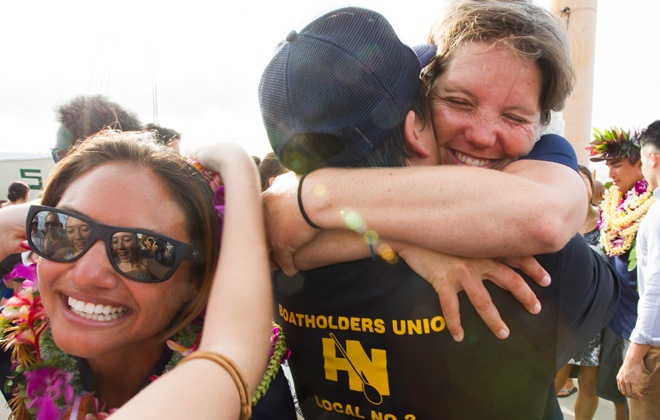Voyagers ‘pulled Hawaii out of the sea’

Voyaging canoe Hikianalia and its crew returned to the Marine Education and Training Center at Sand Island on Tuesday evening. It was the first time the crew stepped off the canoe since leaving Tahiti in May. Hikianalia crew member Kula Barbieto received lei as colleague Maggie Pulver hugged her boyfriend, Chris McManus, upon their arrival home.
After logging some 14,000 miles across the Pacific during the first year of the Malama Honua (“Care for the Earth”) worldwide sail, modern voyaging canoe Hikianalia arrived home safely on Oahu on Tuesday.
Voyage organizers now plan to use the double-hulled vessel, and its unique mix of traditional and modern technology, to sail around the islands and to better connect the local community with Hokule‘a’s travels and mission around the globe.
Hikianalia’s latest 15-person crew, which guided the canoe direct from Tahiti, stepped onto dry land for the first time in 27 days — a bit overwhelmed by the crowd of 200 or so people who came to welcome them, give lei and celebrate the canoe’s return to the islands.
The canoe, built in 2012, has spent the past two months voyaging solo back from New Zealand. An earlier crew sailed Hikianalia from New Zealand to Tahiti.
Veteran Oahu voyager and ‘Iolani School teacher Catherine Fuller led a team of three apprentice navigators during this past leg using the stars and swells to guide Hikianalia home. Leaders of the Polynesian Voyaging Society consider these Pacific legs of the three-year Malama Honua journey to be critical training runs for the new generation of wayfinding navigators.
Fuller and her team said that Mother Nature and night skies blanketed by clouds made navigation difficult to find the way home — but also provided a valuable learning experience.
Don't miss out on what's happening!
Stay in touch with breaking news, as it happens, conveniently in your email inbox. It's FREE!
“The navigation was tough. The winds weren’t the best. The doldrums, we were stuck there for six days or more,” said apprentice navigator Kekaimalu Lee, referring to a stretch of ocean near the equator that is frequently marked by stagnant winds. “But we found home; we pulled Hawaii out of the sea,” he added. (Polynesian voyagers often describe encountering their island destination, as it nears the canoe, as “pulling it from the sea.”)
Hikianalia — called “Hiki” by its crews — has been away for more than a year. The last time the canoe was seen in Hawaii was May 30, 2014, at Palekai Bay, Hilo, as it slipped off with Hokule‘a to begin the round-the-world journey. Hikianalia served as Hokule‘a’s science, technology and safety escort as far as New Zealand.
Many were surprised when Polynesian Voyaging Society President Nainoa Thompson announced late last year that Hikianalia would return to Hawaii instead of pushing on into the unfamiliar and volatile Indian Ocean with Hokule‘a.
However, Thompson said the move was best for safety reasons, and PVS officials see Hikianalia’s return to Hawaii as an opportunity to open up the Malama Honua voyage on a new front, covering an additional 16,000 miles or so of sailing. They plan to bring community members aboard to serve as crew while the canoe spends the next year or so journeying around the islands.
During that time the canoe will sail solo as far as the French Frigate Shoals and as far south as Loihi, a seamount off Hawaii island.
In Hiki’s place, the Gershon II, a modern sailboat equipped with power to tow for longer distances, would accompany Hokule‘a through the Indian Ocean.
Bob Perkins, director of Honolulu Community College’s Marine Education and Training Center, who captained Hikianalia home from Tahiti, said the sail went smoothly. “The greatest thrill for me is the people that I sail with,” Perkins said Tuesday after disembarking from the wa‘a. “You always learn so much more from the people.”
Fuller agreed, recounting her navigation team’s experiences in the doldrums.
“Each one had a night that was just total brain damage, and each one came through and made the right decisions and we got to the right place,” Fuller said. “It really was a test of will and a test of endurance and a test of character for all of us.”
“Sleep is on the agenda,” Fuller added. Several crew members, including Fuller, planned to sleep on Hikianalia on Tuesday night.
Lee said the journey — his longest at sea yet — made him a better navigator.
“We were also told never be afraid to make the mistake, especially in this phase of our growth,” Lee said, “that it was OK to make mistakes and that we needed to make mistakes to learn from them.”




